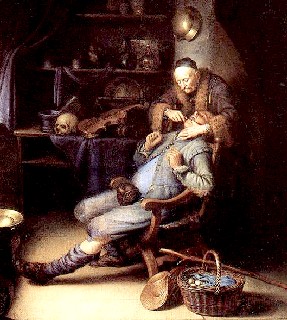
Cauterizing Procedure Page Menu: 1 2 3 4 5 6 7 8 <<First
Cauterizing Procedure During the Golden Age of Piracy, Page 8
Actual Cautery Procedure Continued
Actual Cautery Procedure: Destroying Unwanted Flesh
Military surgeon Richard Wiseman used cautery irons to eliminate gangrenous and cancerous skin. He felt this was the best way to destroy the diseased skin so that the sound skin could grow in its place.
This sounds horrible to us today. However, while cauterizing a cancerous growth, Wiseman reported that it was "a great encouragement to the Patient to see such gobbets burnt off with so little pain."1 His procedure in that case involved the use of several different cautery irons.
Artist: Gerard Dou (1630s)
After I had scooped off what I could of that Lip, then with the Olive and Bolt-like Cauteries by burning I dried up the remainder to a crust. That done, I went to work with the other cancerous Lip which lay stretched along that part of the Jaw to the Cheek, and raised it up as a Trumpeter's in the time of sounding. I passed a Chisel cautery into the body of that, and made a riddance of a great part of it, cutting and burning through the Alveoli [referring here to the sockets in the jaw where the teeth sit], which was as rotten as dirt, till the Patient grew weary, and the Physicians thought it was enough for that time.2
The next day, the Patient returned to have the job finished by Wiseman with another round of cauterization.
I began with that over the Roof, and burnt all that part dry, and left it lying hollow like an Arch: then burnt the other side with Olive and Bolt-cauteries down towards the basis of the Alveoli, and found the remaining sockets full of the same loose Flesh. I burnt into each of them, and at the same time dried them what I could; and where ever I saw any Excrescence, I consumed it, and thereby smoothed my work.3
Wiseman notes in this case that "It was not easie to distinguish the sound from the unsound by reason of the swelling in the neighbouring Parts. It was also much more painful to the Patient, as the sense of the Nerves and Membranes were more exquisite than that of the hard Lips which I consumed the day before."4
In another case of mouth cancer, Wiseman used cautery irons to burn away "Fungus and the rotten Alveoli at twice or thrice repeating the Cautery; then with Bolt cauteries dried the 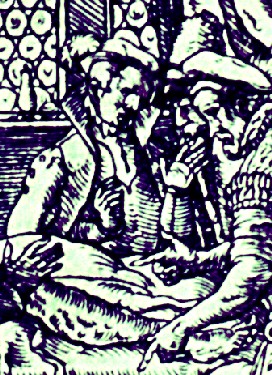
Treating a Gangrenous Leg From Paracelsus
Artzney Buch,
Plate 175 (1565)
basis to a crust. After
with a Scoop-cautery I made a thrust at the fungus over-spreading the left Jaw, and made separation of that, and what was rotten of the Alveoli: then with Olive and Bolt cauteries I dried that as well as he would permit"5.
This patient also returned the next day. Wiseman reported that the "Patient [was] much relieved with the good night's rest he had got: he was chearfull, and resolved for the work. I began with Bolt and Olive cauteries to make an end of drying that Fungus on the left Jaw; which having done, I burnt the salivary Glands on both sides of the Tongue"6
For gangrene, Wiseman explained that when he wanted to avoid the spread of gangrenous skin, "I do rather advise the actual Cautery, for thereby you will not only stop the Bleeding, but dry up the Putrefaction."7 He later explains that "Actual Cautery doth indeed not only resist Putrefaction, but corroborates [strengthens] the Part."8
However, most of Wiseman's case studies concerning gangrene use medicines and scarification - the creating of many small incisions in the gangrened part - for the treatment. When the part is mostly consumed with gangrene, he resorts to amputation to prevent the spread of the infected tissue. Wiseman debates the use of a cauterizing knife as recommended by William Fabry to cut away the dead skin, but warns that "your [heated] Knife will stick fast in the Flesh till the moisture be wholly dried up, and then you must repeate many Knives and Cauteries, in every one of which you will meet the same inconvenience"9. He concludes that regular amputation is preferable to such measures.
1 Richard Wiseman, Eight Chirurgicall Treatises, 3rd Edition, p. 113; 2 Wiseman, p. 113-4; 3,4 Wiseman, p. 114; 5 Wiseman, p. 115-6; 6 Wiseman, p. 116; 7 Wiseman, p. 435; 8 Wiseman, p. 439; 9 Wiseman, p. 441
Actual Cautery Procedure: Treating Rotten Bones
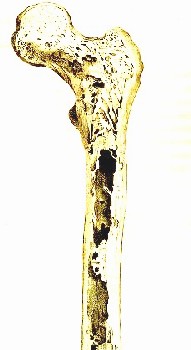
Engraver: Mitchell Edward
From A Series of Engravings
Representing the Bones, Plate XXVIII
Bones can begin to die and rot when they receive inadequate blood flow. Surgeons identified rotting bones by the ulcers in the skin that formed over them. The first thing that can be attempted to treat this problem is to scrape the dead bone away. (This is still done today using curettes designed for scraping.1) However, this procedure didn't always work. As Richard Wiseman explains, "But if the Caries [bone decay] be so deep that you cannot rugine [scrape] it, then with a Terebellum [a sharp instrument] make penetration into it to the sound part, or by an actual Cautery consume the Rottenness."2
Wiseman's procedure for cauterizing rotten bones used a cannula or tube that was inserted into an ulcer so that the red hot end of the iron didn't touch the surrounding skin as it was being inserted to burn the caries of the bone. He explains:
...you shall place the Cannula upon the carious Bone, having first cleanse[d] the Matter from it with armed Probes [probes with bits of cloth attached to end of them]: then pass the actual Cautery down through the Cannula to the Bone so often till you have dried it, pulling out the Cannula after each heat. So you may perform the work without scorching the Lips of the Ulcer.
According as the Bone is rotten, so the Humour [fluids resulting from the rotting, thought to be bad humors] will spurt out from it upon the first application of the Cautery: but upon repeating it, that Bone will be so dry that you shall not hear it hiss; besides, you may feel the Bone firm.3
1 "Causes of Isochemic Bone Damage", The Maxillofacial Center for Diagnostics & Research, gathered 9/14/14; 2,3 Richard Wiseman, Eight Chirurgicall Treatises, 3rd Edition, p. 183
Actual Cautery Procedure: Use in Hernia Operations
Use of cautery irons to treat hernias have a long pedigree, going all the way back to the works of Hippocrates.

Image: Bruce Blaus - The Inguinal Hernia
Richard Wiseman begins by explaining that for hernias during the late 17th century, "These ways [cauterization] are not practiced amongst our people, they esteeming such Operations full of hazard and cruelty: yet they having been delivered to us by good Authority, I shall shew you how they are performed, and begin with that of actual Cautery. In the effecting of which work there are required various sorts of Buttons [button cauteries], some bigger and less than other."1
Wiseman then proceeds to explain how the procedure was performed. He has the patient stand and hold his breath as was discussed, allowing the hernia to be located and identified. Once the location is identified, Wiseman explains that the procedure is to press "your hot Cautery on the middle of that Triangle [drawn onto the skin by the surgeon to identify the location], and repeat it often, making the form of the Greek Letter Γ so deep till you reach to the Membrana adiposa [a membrane of fat around the hernia], taking care you do not scorch the Peritonœum [membrane that lines the abdominal cavity]: then dress the burned parts with a little Salt and an Onion beat together [an immediate and temporary cure for burning], and afterwards digest and heal the Ulcer as you find proposed in the Chapter on Burns, he keeping his bed till he be cured."2
1 Richard Wiseman, Eight Chirurgicall Treatises, 3rd Edition, p. 152; 2 Wiseman, p. 152-3
Actual Cautery Post-Operative Medicines
Some
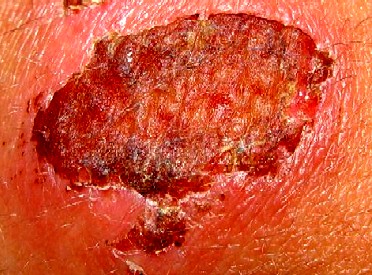
A Burn Eschar
of the medicines given after cauterization have already been discussed in this article. Remedies such as onions, oils and butter used to soothe burns were also used for topical cauterization.1 For an extensive list of period burn remedies that might have been employed topically, see this page of the Treating Burns During the Golden Age of Piracy article.
Since the majority of the more descriptive cauterizing procedures come from Richard Wiseman's book, a lot of the more curative medicines come from there as well. Wiseman has a tendency not to give the conventional medicines found in pharmacopoeias of the time (or at least not to give a medicine's conventional name). Since it was normal to give any medicinal prescription in Latin at this time, often abbreviating various ingredients as it suited the author, Wiseman's recommendations can be a bit hard to decipher. However, we'll review a few of them.
After finishing a long round of cauterization of cancerous skin in the mouth, Wiseman gave his patient "this Lotion to hold in his Mouth to cool it: Rx. Em cydonior. [take a quince] {1 ounce} sem.
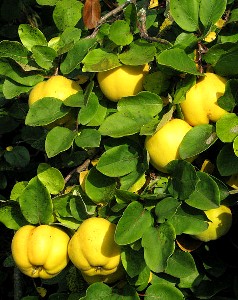
Photo: Dietrich Krieger - Quince Fruit
psyllii [plantago] & papaver. albi [white poppy opium] an. {2 drams} extrahantur mucores [draw salted] in aq. plantag. [in plantago water] solan. & ranar. an. part. æq. [in equal parts]"2.
You may already begin to see the problem with reading his prescriptions. It is notable that this concoction contained opium, which would no doubt have produced tremendous relief of the pain experienced by the patient. Quinces have been found to have wound healing properties3 and some plantains (including English plantain) are believed to help soothe pain and swelling.4 So Wiseman seemed to know his medicines, even if the recipes are a bit hard to decipher.
In another, similar case, he gave basically the same ingredients in barley water, adding egg white, which was thought to have cooling and soothing properties. He added a "Defensative" plaster which was to be applied under the jaw. It contained a variety of herbals, drying earths such as bole Arminiak, pulverized flowers of red roses, pomegranates and sumac along with rose and myrtle oils. This usefulness of this plaster would seem to lie more in its scent than its medicinal properties.5
Wiseman also specified a topical for use after cauterizing a rotting bone. It contained "the white of Eggs beaten with the Mucilage of Quince seeds extracted in aq. germ. querc. [water of pedunculate oak] Or the like, and dress the scorched Ulcer and Lips with unguent. refriger. Galeni [cold cream], and a Cerote [an unctuous mixture] of the same over that and the neighboring Parts."6 Here, Wiseman is once again on a sound footing with medicinal elements that would be cooling and soothing to burns.
1 See for example, Richard Wiseman, Eight Chirurgicall Treatises, 3rd Edition, p. 153; 2 Wiseman, p. 114; 3 P. Tamri, A. Hemmati & MG Boroujerdnia,"Wound healing properties of quince seed mucilage: In vivo evaluation in rabbit full-thickness wound model.", www.ncbi.nlm.nih.gov, gathered 9/18/14; "BUCKHORN PLANTAIN", webmd.com, gathered 9/18/14; 5 Wiseman, p. 116; 6 Wiseman, p. 183

